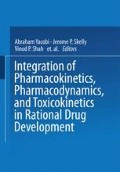Abstract
It is important to recognize that the new drug development process, which begins with the identification of a potential therapeutic compound, continues well into the post-marketing period. The responsibility of regulators, scientists, physicians, and the pharmaceutical industry to pursue knowledge about drug safety and efficacy extends well beyond the time when sufficient information is available to suggest that a drug is safe and efficacious, and warrants marketing. The ultimate uses of newly marketed medications and the clinical milieu into which it will be interposed is extremely dynamic and complex. It is during the early marketing period that a number of drugs approved for marketing were discovered to have serious, unanticipated adverse events requiring at best a change in labeling; and at worst removal from the market at great cost, in terms of credibility and dollars, to both FDA and the pharmaceutical industry (FDA Drug Review, 1990).
Access this chapter
Tax calculation will be finalised at checkout
Purchases are for personal use only
Preview
Unable to display preview. Download preview PDF.
References
Antal, E. J., T. H. Grasela, and R. B. Smith (1989). An evaluation of population pharmacokinetics in therapeutic trials Part III. Prospective data collection versus retrospective data assembly. Clin. Pharmacol. Ther. 46, 552–559.
Antal, E. J., D. A. Pyne, K. E. Starz, and R. B. Smith (1988). Probability models in pharmacodynamic analysis of clinical trials. In P. Kroboth and R. B. Smith (Eds.), Current Problem and Potential Solutions. Vol. 2. Harvey Whitney Books, Cincinnati. pp. 220–231.
Beal, S. L., and L. B. Sheiner (1982). Estimating population kinetics. CRC Crit. Rev. Biomed. Engineering 8, 195–222.
Beal, S. L., and L. B. Sheiner (Eds.), (1983). NONMEM Users Guide - Part VI: PREDPP Guide. NONMEM Project Group, University of California at San Francisco, San Francisco, CA.
FDA Drug Review (1990). Post-approval risks 1976–85. United States General Accounting Office, Report to the Chairman, subcommittee on Human Resources and Intergovernmental Relations, Committee on Government Operations, House of Representatives. PEMD–90–15.
Grasela, T. H., and M. W. Dreis (1992). An evaluation of the quinolone-theophylline interaction using the FDA Spontaneous Reporting System. Arch. Intern. Med., 152 617–621.
Holford, N. H. G., and L. B. Sheiner (1981). Understanding the dose-effect relationship: clinical application of pharmacokinetic-pharmacodynamic models. Clin. Pharmacokinet. 6 429–453.
Hosmer, D. W., and S. Lemeshow (Eds.), (1989). Applied Logistic Regression. John Wiley and Sons. New York.
Lee, E. T. (1980). Statistical Methods for Survival Data Analysis. Lifetime Learning Publication, Belmont, CA.
Ludden, T. M. (1988). Population pharmacokinetics. J. Clin. Pharmacol. 28, 1059–1063.
MacMahon, B., and T. F. Pugh (Eds.), (1970), Epidemiology Principles and Methods Little, Brown and Company, Boston.
Peck, C. C., and J. H. Rodman (1986). Analysis of clinical pharmacokinetic data for individualizing drug dosage regimens. In W. E. Evans, J. J. Schentag, and W. J. Jusko (Eds.), Applied Pharmacokinetics 2nd edition, Applied Therapeutics, Inc., Spokane, WA, pp. 55–82.
Sheiner, L. B., and S. L. Beal (1983). Evaluation of methods for estimating population pharmacokinetic parameters. III. Monoexponential model: Routine clinical pharmacokinetic data. J. Pharmacokinet. Biopharm. 3, 303–319.
Sheiner, L. B., and L. Z. Benet (1985). Premarketing observational studies of population phannacokinetics of new drugs. Clin. Pharmacol. Ther. 38, 481–487.
Strom, B. L. (Ed.), (1989). Pharrnacoepidemiology. Churchill Livingstone, New York.
Author information
Authors and Affiliations
Editor information
Editors and Affiliations
Rights and permissions
Copyright information
© 1993 Springer Science+Business Media New York
About this chapter
Cite this chapter
Grasela, T.H., Antal, E.J. (1993). Pharmacoepidemiology, Population Pharmacokinetics and New Drug Development. In: Yacobi, A., Skelly, J.P., Shah, V.P., Benet, L.Z. (eds) Integration of Pharmacokinetics, Pharmacodynamics, and Toxicokinetics in Rational Drug Development. Springer, Boston, MA. https://doi.org/10.1007/978-1-4757-1520-0_16
Download citation
DOI: https://doi.org/10.1007/978-1-4757-1520-0_16
Publisher Name: Springer, Boston, MA
Print ISBN: 978-1-4757-1522-4
Online ISBN: 978-1-4757-1520-0
eBook Packages: Springer Book Archive

